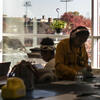Tyler students have access to the abundant resources of a large, tier-one public research university and accomplished faculty who model a culture of inquiry through their own research and professional practice.
Research Opportunities
Students in Tyler’s 22 academic disciplines can participate in research opportunities such as architecture and environmental design, art history, city/regional planning and community development, sculpture, and visual studies.
The Diamond Research Scholars Program provides rising sophomores, juniors and seniors the opportunity to engage in a focused, mentored research or creative arts project during the summer and fall.
Tyler and Temple University are closely tied to the city of Philadelphia, providing opportunities for undergraduate students to participate in hands-on, collaborative opportunities in the city. The richness of arts practice, architecture, landscape architecture, planning and allied professional fields across the Philadelphia region offers limitless possibilities for experiential learning.
Fibers and Materials Studies Facilities
Tyler’s fibers and materials studies studios are equipped with state-of-the-art tools for weaving, knitting, sewing and other fiber practices, including a Jacquard loom TC2; tufting guns; a long-arm sewing machine; embroidery machines and ultramodern dye lab; and a computer lab for silk screening and digital printing, design software and a large-format printer that can print on 46-inch wide bolts of fabric. The facility also includes a large assembly area, color-corrected lighting, yarn storage and private graduate studios.

